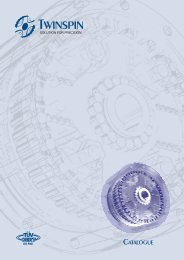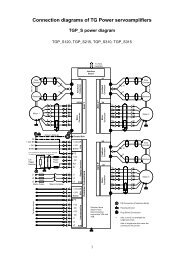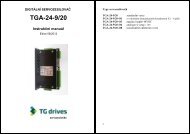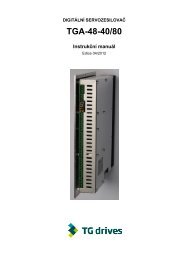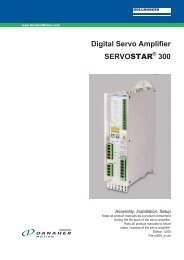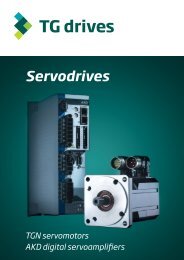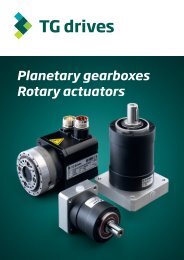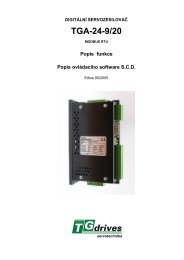Table of Contents - TG Drives
Table of Contents - TG Drives
Table of Contents - TG Drives
You also want an ePaper? Increase the reach of your titles
YUMPU automatically turns print PDFs into web optimized ePapers that Google loves.
EXTENDED REGISTER GROUPS<br />
RD1, Resolver/Digital converter #1.<br />
RD1.Mode=3 Active and High-speed mode selected. This mode is<br />
recommended for use above 500 Hz (or 30.000 rpm 2-pole<br />
speed). It is also suitable for already demodulated resolvers<br />
and transducers giving a similar signal, for sensors ranging<br />
from analog hall sensors to laser interferometers. The<br />
maximum internally supported speed is 32 MHz.<br />
RD1.Mode=5<br />
RD1.Mode=6<br />
RD1.Mode=7<br />
RD1.Mode=13<br />
RD1.Mode=14<br />
RD1.Mode=15<br />
Use RD1 correction table (see RD1CORR group). The<br />
uncorrected RD1 position is located in the table (there is 16<br />
values/turn), and the result is added to the RD1 position before<br />
the value is used for commutation and regulation.<br />
Use and update RD1 correction table (see group RD1CORR).<br />
For the update mode to work, the motor should be running with<br />
no load at a recommended minimum high speed <strong>of</strong> 256000.<br />
The system then assumes that all torque fluctuations in the<br />
regulator are due to imperfections in the resolver, and adjusts<br />
the table to minimize these fluctuations. This adjustment may<br />
take several seconds. While the update mode is active, no<br />
speed changes are allowed.<br />
This automatic mode is most suitable for low-accuracy<br />
resolvers such as analog hall-sensors etc. To use the correction<br />
for a DMC 2 standard resolver, a PL-code routine must be<br />
written and the adjustment time increased to minutes or no<br />
improvement will occur.<br />
RD1.Mode=16 High resolution mode.<br />
Pulses-per-revolution has been increased to accommodate the<br />
14-bit A/D converter capability. High resolution is a new<br />
operating mode in RD1 and RD2 separatly.<br />
One revolution <strong>of</strong> a 2 pole resolver yields 65536 increments,<br />
this is eight times better than the low resolution mode.<br />
i<br />
i<br />
Several group members must be scaled up or down by 8<br />
when using this mode.<br />
Pg.Speed = multiply by 8 to achieve the same speed as for low<br />
resolution.<br />
Pg.Acc/Pg.Ret = multiply by 8 to achieve the same<br />
acceleration/deceleration as for low resolution.<br />
Reg.Xgain= divide by 8 all gains. Where X is P, I or D for low<br />
resolution.<br />
Motor.PPR= multiply by 8 for low resolution.<br />
When this mode is activated ,the RD2 supervision is also<br />
activated, regardless <strong>of</strong> the mode setting in RD2.Mode.<br />
That is, if the RD2 resolver is deactivated, no check is<br />
performed. Currently the RD2 can not be compensated.<br />
If RD2 is enabled then in the case the RD2.Ampl falls below<br />
RD2.ChkLowLim then a resolver error interrupt is<br />
generated and a reason code is stored in RD2.ChkErr.<br />
The standard method will generate interrupts as soon as<br />
the interrupt vector has been defined and the interrupt has<br />
been enabled. This version will start after this mode bit is<br />
activated. When you run code that is designed to find<br />
values for RD1.SHAdj you should make sure that the<br />
interrupt is not enable and that this mode is disabled. And<br />
before you enter this mode then clear any pending resolver<br />
User's Manual 5.1 Inmotion Technologies AB<br />
Doc. No.9032 0027 01 (B), Rev. 11.07.2001<br />
59



